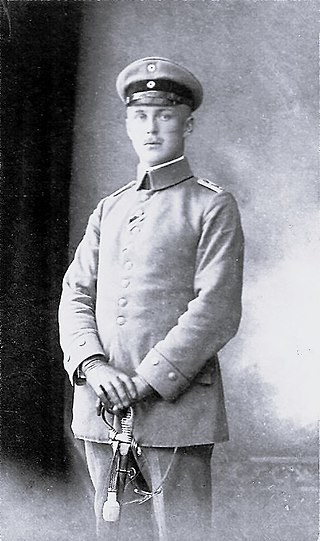Corporal is a military rank in use by the armed forces of many countries. It is also a police rank in some police services. The rank is usually the lowest ranking non-commissioned officer. In some militaries, the rank of corporal nominally corresponds to commanding a section or squad of soldiers.
Stabshauptmann meaning "Staff Captain", is a German Senior Captain rank and the highest military rank in the Bundeswehr for specialist officers.
Schütze in German means "rifleman" or "shooter", or in older terms originally connoted "archer" before the advent of the rifle. It also occasionally occurs as a surname, or as Schütz, as in the opera Der Freischütz. The word itself is derived from the German word schützen, meaning to protect, or to guard. It was originally used for archers as they protected castle walls, and is the German equivalent to Sagittarius, the mythical form which held bow and arrow.
Gefreiter is a German, Swiss and Austrian military rank that has existed since the 16th century. It is usually the second rank or grade to which an enlisted soldier, airman or sailor could be promoted.
Obergefreiter is an enlisted rank of the German and Swiss militaries which dates from the 19th century.
Feldwebel is a non-commissioned officer (NCO) rank in several countries. The rank originated in Germany, and is also used in Switzerland, Finland, Sweden, and Estonia. The rank has also been used in Russia, Austria-Hungary, occupied Serbia and Bulgaria.
Unteroffizier is a junior non-commissioned officer rank used by the Bundeswehr. It is also the collective name for all non-commissioned officers in Austria and Germany. It was formerly a rank in the Imperial Russian Army.
Bootsmann is a naval rank used in some navies.

Unteroffizier(e) mit Portepee, also Portepeeunteroffizier(e) (transl. Non-commissioned officer(s) with sword knot), is the designation for German senior non-commissioned officers in the armed forces of Germany. The title derives from the French porte-épée ("sword bearer"), as senior enlisted men would historically carry a sword into battle.
Seekadett is a military rank of the Bundeswehr and of former German-speaking naval forces.
Korporal is the German and Danish spelling of the English corporal. Korporal is used in a number of armed forces as the lowest rank of the non-commissioned officers group. However, in the German Bundeswehr, it is considered a high enlisted personnel rank. In Switzerland the rank is used in the Fire Department as well.
The rank insignia of the federal armed forces of the Federal Republic of Germany indicate rank and branch of service in the German Army, German Air Force, or the German Navy.
Fahnenjunker is a military rank of the Bundeswehr and of some former German armed forces. In earlier German armed forces it was also the collective name for many officer aspirant ranks. It was established by the Presidential order of the Federal president on rank insignia and uniforms of soldiers.
The ranks of the German Armed Forces,, were set up by the President with the Anordnung des Bundespräsidenten über die Dienstgradbezeichnungen und die Uniform der Soldaten on the basis of section 4, paragraph 3 of the Soldatengesetz. The Bundesbesoldungsordnung regulates the salary scales of all Federal office holders and employees including soldiers. The 'ZdV-64/10 – Abkürzungen in der Bundeswehr' gives the abbreviations and a list of the abbreviations.
This article deals with the rank insignia of the Austro-Hungarian Army, as worn by the Austro-Hungarian Army after the reorganisation in 1867 until 1918.
Obermaat is a military rank of the Bundeswehr and earlier other German-speaking armed forces.
Soldat is the lowest rank of enlisted men in the land-based armed forces of Germany, Austria and Switzerland. It is usually grouped as OR-1 within the NATO ranking system, excluding the Swiss armed services which is not part of NATO.
Oberbootsmann designates in the German Navy of the Bundeswehr a military person or member of the armed forces. It belongs to the particular rank group Senior NCOs with port epée.
Stabsunteroffizier is a military rank of the German Bundeswehr. It was preceded by the rank Unterfeldwebel that was used between 1935 and 1945 in the armed forces of Nazi Germany, the Wehrmacht. The East German National People's Army used the rank Unterfeldwebel from 1956 to 1990. In the Austrian Armed Forces Stabsunteroffizier is the collective name to all higher Non-commissioned officers.
The military ranks of the German Empire were the ranks used by the military of the German Empire. It inherited the various traditions and military ranks of its constituent states.






